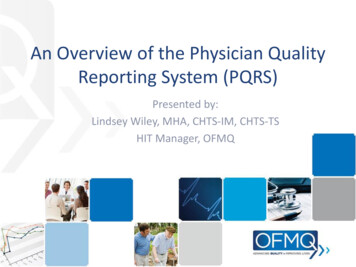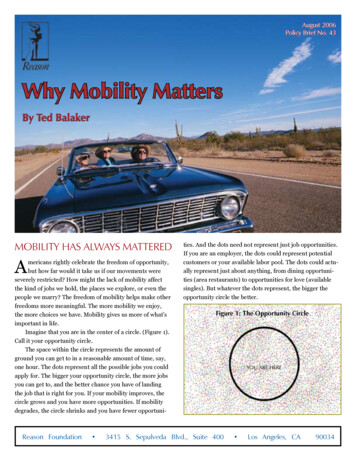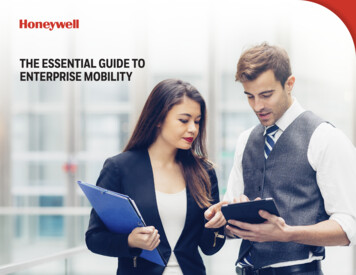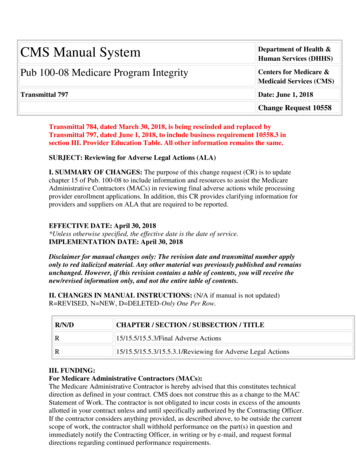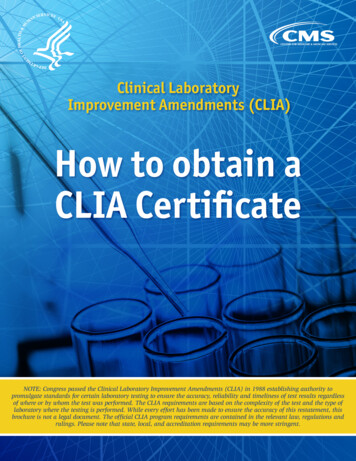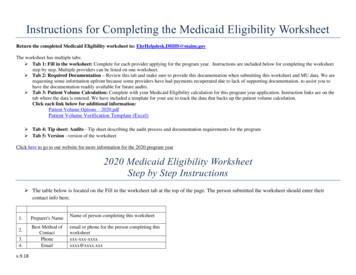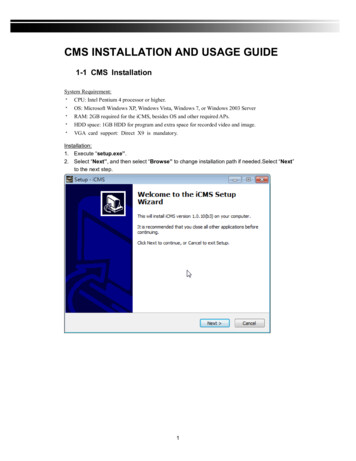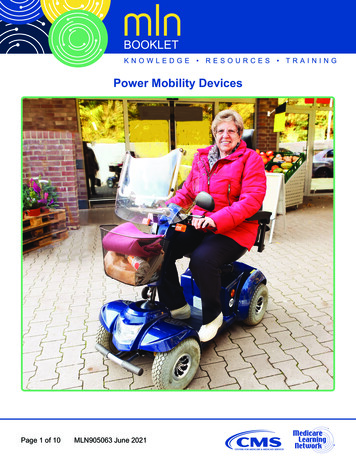
Transcription
Power Mobility DevicesPage 1 of 10MLN905063 June 2021
Power Mobility DevicesMLN BookletTable of ContentsWhat’s Changed? . 3Introduction. 4Coverage Criteria. 4PMDs . 4POVs . 5PWCs . 5Master List. 6Practitioner Requirements. 6Face-to-Face Encounter . 7Documenting the Face-to-Face Encounter . 7Standard Written Order . 8Supplier Requirements . 9SWO & Face-to-Face Encounter Documentation . 9Home Assessment . 9POD . 9DMEPOS Competitive Bidding Program . 10Resources . 10Page 2 of 10MLN905063 June 2021
Power Mobility DevicesMLN BookletWhat’s Changed? Added: Policies effective 01/01/2020 establishing a standardized set of required elements for allDMEPOS orders and creating 1 master list of DMEPOS items requiring a face-to-faceencounter (pages 4 & 6) Standard Written Order (SWO) requirement (page 8) Statement that if supplier doesn’t get a Power Mobility Device (PMD) SWO or prescriptionbefore delivery, Medicare denies the claim as not reasonable and necessary (page 6) Complete face-to-face encounter 6 months before the order (page 6) Master List information Removed: 7-element order Detailed product description requirement References to 45-day order time frame and face-to-face documentation receipt Information indicating PMD supplier must complete delivery within 120 days followingface-to-face exam Date stamp or equivalent requirement Revised: Face-to-face exam to face-to-face encounter (page 7)You’ll find substantive content updates in dark red font.Page 3 of 10MLN905063 June 2021
Power Mobility DevicesMLN BookletIntroductionMedicare Part B covers Durable Medical Equipment, Prosthetics, Orthotics, and Supplies (DMEPOS)if a qualified practitioner prescribes it for use in a patient’s home and documents medical necessity incompliance with coverage requirements. Medicare covers Power Mobility Devices (PMDs), includingPower Wheelchairs (PWCs) and Power Operated Vehicles (POVs), under the Mobility AssistiveEquipment category of Durable Medical Equipment (DME).Effective January 1, 2020, we finalized Medicare policies that: Established 1 standardized set of required elements for allDMEPOS orders Created 1 Master List of DMEPOS Items that could requirea face-to-face encounter and a written order before deliveryor prior authorizationDid You Know?Insufficient documentation andmedical necessity errors causemost PMD improper payments.“Prior authorization” is when a provider or supplier requests an item review before delivery to thepatient. After Medicare reviews the prior authorization request, they will issue a provisional affirmation(approved) or non-affirmation (non-approved). Failure to get approval before item delivery will result inclaim denial.Coverage CriteriaPMDsMedicare only covers medically necessary PMDs. A PMD is considered medically necessary when apatient meets all these general coverage criteria: Their mobility limitation significantly impairs their ability to participate in 1 or more Mobility-RelatedActivities of Daily Living (MRADLs) in typical locations within the home, such as the kitchenor bathroom Their mobility limitation isn’t sufficiently and safely resolved by using an appropriately fitted caneor walker They don’t have enough arm and hand strength to operate an optimally configured manualwheelchair to perform MRADLs at home during a typical day An optimally configured manual wheelchair is 1 with an appropriate wheelbase, device weight,seating options, and other appropriate non-powered accessoriesPage 4 of 10MLN905063 June 2021
Power Mobility DevicesMLN BookletPOVsPatients qualify for a POV or scooter if they meet all general PMD coverage criteria plus: They can do all these actions: Safely transfer to and from a POV Operate tiller steering system Maintain postural stability and position while operating POV at home They have sufficient mental and physical abilities to safely operate a POV at home They meet POV weight capacity requirements; their weight must be both: Less than or equal to POV maximum weight capacity Greater than or equal to 95% of capacity of next lower POV weight class capacity Their home allows adequate POV access between rooms, maneuvering space, and surfaces Using a POV will significantly improve their ability to participate in MRADLs, and they’ll use it at home They haven’t expressed an unwillingness to use a POV at homePWCsPatients qualify for a PWC if they meet all general PMD coverage criteria plus: They don’t meet all POV coverage criteria (POV isn’t appropriate based on thepatient and environmental assessment) They have sufficient mental and physical abilities to safely operate the PWC or have a caregiverwho can’t adequately propel an optimally configured manual wheelchair They meet PWC weight capacity requirements; their weight must be both: Less than or equal to PWC maximum weight capacity Greater than or equal to 95% of capacity of next lower PWC weight class capacity Their home allows adequate PWC access between rooms, maneuvering space, and surfaces Using a PWC will significantly improve their ability to participate in MRADLs, and they’ll use thePWC at home They haven’t expressed an unwillingness to use a PWC at homeSpecific PWCs have additional coverage criteria applied. Find more information on your PMDLocal Coverage Determination in the Medicare Coverage Database.Page 5 of 10MLN905063 June 2021
Power Mobility DevicesMLN BookletMaster ListMedicare requires some DMEPOS to meet extra criteria before they’re covered. In 2020, we createda library known as the “Master List” that compiles all DMEPOS items that, if selected, may requireproviders or suppliers to meet additional payment requirements. We make the list of selected itemsfrom 2 smaller lists known as: Required Face-to-Face Encounter and Written Order Prior to Delivery List; this list includes all PMDs Required Prior Authorization ListWe can add Master List items to 1 or both lists. We include PMDs on the Required Face-to-FaceEncounter and Written Order Prior to Delivery Lists.Practitioner RequirementsFor us to cover a patient’s PMD item, the treating practitioner must: Conduct face-to-face encounter Document face-to-face encounter Send “prescription” (known as the Standard Written Order [SWO]) to supplier, along withsupporting documentation Practitioner who performed the face-to-face encounter must write the SWO Practitioner must order the SWO within 6 months after face-to-face encounter“Practitioners” (physicians or Non-Physician Practitioners [NPPs]) and suppliers should work togetherto ensure they meet all these requirements before delivering a DMEPOS item. If the supplier doesn’tget the PMD SWO before delivery, we deny the claim.Many suppliers create PMD documentation templates. Templates can help with claim submissions.While you may complete template forms and include them in the patient’s chart, they aren’t asubstitute for the comprehensive medical record. We don’t allow suppliers to complete any partof these forms. We encourage suppliers to help educate practitioners on the type of informationneeded to document a patient’s mobility needs.Page 6 of 10MLN905063 June 2021
Power Mobility DevicesMLN BookletFace-to-Face EncounterA “face-to-face encounter” is an in-person or telehealth encounterbetween you and the patient. If you perform the encounter via telehealth,you must also meet the telehealth services requirements to get paid.In the face-to-face encounter, gather information related to diagnosing,treating, or managing the patient’s clinical condition that requires theDMEPOS item.In this section, yourefers to treating orordering practitioner.During the face-to-face encounter, you should: Evaluate and treat patient for their medical conditions Tailor evaluation to individual patient’s condition(s) Determine PMD medical necessity as part of appropriate overall treatment plan Document a mobility exam was a major reason for the visit Answer these questions about the patient: What is their mobility limitation, and how does it interfere with performing MRADLs? Why won’t a cane or walker meet their home mobility needs? Why won’t a manual wheelchair or POV meet their home mobility needs? Do they have the physical and mental abilities to safely transfer into and safely operate a PMDat home?A new face-to-face encounter isn’t required if: PMD is replaced during the 5-year useful lifetime of item in same Medicare performancegroup previously covered You’re only ordering PMD accessories that aren’t included on the Required Face-to-FaceEncounter and Written Order Prior to Delivery ListsDocumenting the Face-to-Face EncounterYou must document the patient’s face-to-face encounter in a detailed, narrative note in their medicalrecord. The record should include relevant information about these elements (each element doesn’tneed addressed in every evaluation) and may include other details: Document patient’s present and past medical history of mobility needs, including: Symptoms and diagnoses limiting ambulation Medications or other symptom treatment Progressive ambulation difficulty over time Other related ambulatory problem diagnosesPage 7 of 10MLN905063 June 2021
Power Mobility Devices How far they can walk without stopping How fast they can walk What they currently use for ambulatory help What changed that they need a PMD Standing up without help from a seated position Description of home setting and patient-ability to perform MRADLs at homeMLN Booklet Document their physical exam: Weight and height Cardiopulmonary exam “Musculoskeletal exam” (arm and leg strength and range of motion) “Neurological exam” (gait, balance, and coordination) Ensure medical record documentation supports the medical need in the home: Include important lab tests, X-rays, or other diagnostic tests about their mobility needs Document PMD prescribing decisionStandard Written OrderThe treating practitioner who completes the patient’s face-to-face encounter must prepare a “SWO.”The SWO is written communication from a treating practitioner that documents the patient’s DMEPOSitem need.All DMEPOS items require you to send the SWO to the supplier before the supplier can submit theclaim. Some items, like power wheelchairs, require you to send the SWO to the supplier before theydeliver the ordered item.The SWO must include all these elements: Patient’s name or Medicare Beneficiary Identifier (MBI) General item description (for example, wheelchair or hospital bed, brand name or model number,HCPCS code, or HCPCS code narrative) Quantity you want dispensed, if applicable Date ordered Treating practitioner name or National Provider Identifier (NPI) and signaturePage 8 of 10MLN905063 June 2021
Power Mobility DevicesMLN BookletSupplier RequirementsPMD suppliers must satisfy certain Medicare requirements to get paid. You must keep these documents: SWO & face-to-face encounter supporting documentation Written home assessment report Proof of Delivery (POD)In this section, yourefers to PMD suppliers.SWO & Face-to-Face Encounter DocumentationYou must: Get a written, signed, and dated SWO before delivering the PMD. However, if a particularPMD doesn’t appear on the prior authorization list, submit the order to the supplier before claimsubmission. Only power wheelchairs require the written order prior to delivery. Keep and make this and other medical records available on request.Home AssessmentYou or the ordering practitioner must perform an on-site patient home evaluation before or during thePMD delivery. Include a written report with this evaluation. The evaluation must verify the patient canadequately maneuver the PMD, considering all these: Physical layout Doorway width Doorway thresholds Surfaces Home assessment written report available on requestPODPOD helps determine correct PMD coding and billing. Ensure the claim’s date of service is the dateyou deliver the patient’s PMD.If you deliver directly to the patient, you must document: Patient’s name Delivery address Sufficiently detailed item description Quantity delivered Date delivered Patient (or designee) signaturePage 9 of 10MLN905063 June 2021
Power Mobility DevicesMLN BookletIf you deliver the patient’s PMD using a hired shipping service, you must document: All above-listed criteria Shipping service’s package identification number linking your delivery documents to shippingservice’s records Delivery evidenceDMEPOS Competitive Bidding ProgramUnder DMEPOS Competitive Bidding Program, DMEPOS suppliers compete to become Medicarecontract suppliers by bidding to provide certain medical equipment and supplies to patients living in orvisiting competitive bidding areas.Resources 2019 Final Rule Affecting PMDs 42 CFR Section 410.38 Complying with Medicare Signature Requirements Medicare Claims Processing Manual, Chapter 20 MLN Matters Article SE20007, Standard Elements for DMEPOS Order, and Master List ofDMEPOS Items Potentially Subject to a Face-to-Face Encounter and Written Orders Prior toDelivery and, or Prior Authorization Requirements Provider ComplianceMedicare Learning Network Content Disclaimer, Product Disclaimer, and Department of Health & Human Services DisclosureThe Medicare Learning Network , MLN Connects , and MLN Matters are registered trademarks of the U.S. Departmentof Health & Human Services (HHS).Page 10 of 10MLN905063 June 2021
Power Mobility Devices MLN Booklet Page 4 of 10 MLN905063 June 2021. Introduc


